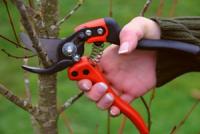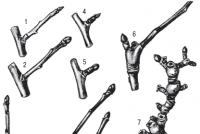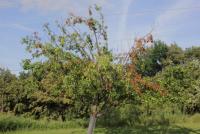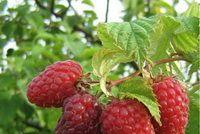Pruning tree cherry in spring. Correct pruning cherries young, old, felt, spring or autumn?
At the time of flowering, the cherry is a beautiful and elegant bride, and the owner with pride is already beginning to count her future harvest in the equivalent of buckets. But all the flowers do not always reach ripe berries, and this is due to many factors, including proper plant care: pruning cherries in the spring (standard scheme) and in the fall, feeding, watering, spraying and other measures.
For cherries, the most important thing is to form a crown with the main trunk of a longline type. As the tree grows with age, it is necessary to gradually cut out the main shoots, but not too much, since the cherry is a heat-loving culture, therefore intensive cutting of the cherry in spring, multiplied by severe frosts in winter, will simply ruin the plant.
This tree, like many stone fruits, needs at least two treatments per year: spring and autumn. Plan this procedure should be based on the climatic zone of growth. It should also be noted that the annual young saplings do not need autumn pruning, due to the same characteristics of the cherry - it is difficult to tolerate frosts.
Cherry Cutting Tool
Not only the correct pruning depends on the quality of the tool, but also the time within which the tree can recover. To carry out this procedure should be used:
- garden knife, necessary when cutting thin branches;
- a saw for cutting large branches of a tree;
- garden pruners.
The entire instrument should be kept clean and as sharp as possible. In addition, during the work, you will need to use a garden pitch, which is used to process all cutting sites. 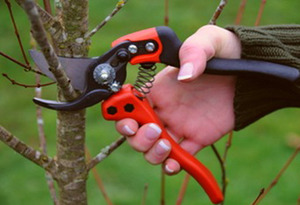
What is pruned cherry in spring
Cherries need systematic pruning, it must be carried out in order to:
Basic requirements for proper pruning in spring
To cut the branches did not harm the fruit tree, adhere to the basic requirements made by the specialists in gardening:
If the cherry rushed up, in a timely manner get rid of the shoots growing to the top.
Cut branches from a bush cherry that are longer than 0.5 m.
If you leave the side shoots, the tree will acquire the correct crown, consisting of strong 15 branches.
Getting rid of dry branches is necessary for prophylactic purposes.
Stick to a sparse-tiered or combined tree cherry growing scheme.
If for a year the growth of shoots does not exceed 15 cm, it is time to take up the rejuvenating pruning of the fruit plantation.
Pruning bush and tree cherry in spring
The pattern of trimming a bush cherry is in the following steps.
- With the exposure of the ends of the branches, pruning is done on the third part or in half.
- Skeletal and semi-skeletal branches are cut near the buds or branches.
- You can not cut both types of branches at once.
- “Purge”, depending on the type of stems, is alternated annually.
- Do not remove young shoots.
- It is preferable to remove shoots of a length of about sixty centimeters.
- Cut branches on the side branches.
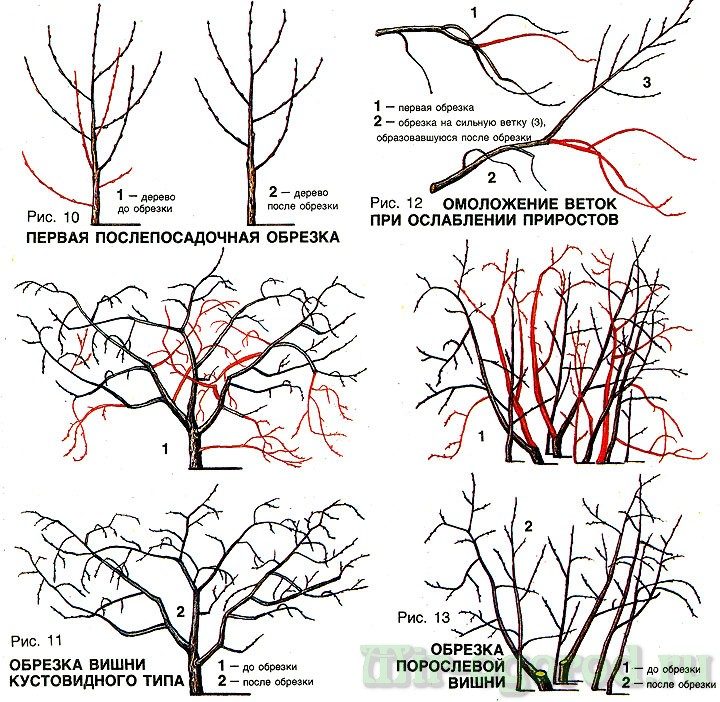 There are some distinctive features between pruning an adult plant and a seedling. During the implementation of the planting, the strongest stem is determined, and in the crown of the cherry, five stalks located at a short distance between themselves are not cut. They are cut off at an angle. Remove the stems grown on the trunk. And cut crossed. An adult tree is cut with the aim of keeping the cherry healthy and strong. Shoots are reduced to the third part, if they are located on a bare branch, old and diseased are removed.
There are some distinctive features between pruning an adult plant and a seedling. During the implementation of the planting, the strongest stem is determined, and in the crown of the cherry, five stalks located at a short distance between themselves are not cut. They are cut off at an angle. Remove the stems grown on the trunk. And cut crossed. An adult tree is cut with the aim of keeping the cherry healthy and strong. Shoots are reduced to the third part, if they are located on a bare branch, old and diseased are removed.
Pruning a young cherry in spring
Pruning a young cherry in the spring of next year after planting a sapling is a very important event. If, over the course of several years, to adhere to the chosen processing scheme, then in most cases one pruning per year can suffice - namely, spring. It can not be called more important than autumn, because each of them has different goals. But the fact is that even if you are not sure about the result or a beginning gardener, then before the winter, in the autumn pruning, you can still adjust your work. 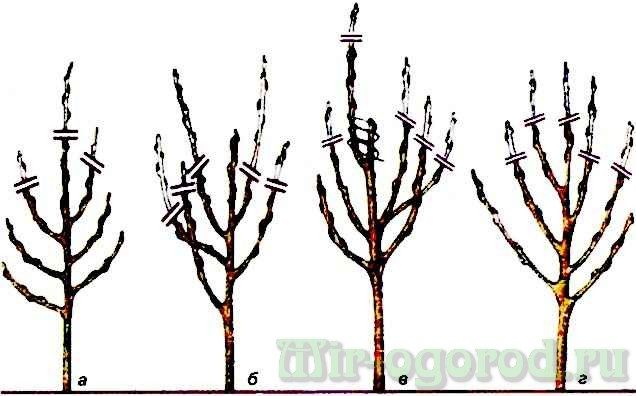
Pruning cherry spring
When pruning fruit-bearing cherry trees, you should reduce the length of bare branches, as well as shorten the path of nutrient inputs from the roots to the crown. Developed annual growths are cut minimally. 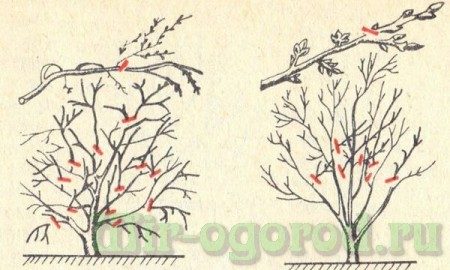
Many people know that a regular and abundant harvest of cherry berries depends on the correct and timely cutting of the crown of the tree. As a rule, the formation of the crown of trees made to engage in the spring or autumn. Spring pruning of cherries allows you to free the tree from old, sick and broken branches under the weight of snow. However, it does not always remove only the old and diseased branches, sometimes you have to clean up completely fresh. What is it for? How to make pruning?
The process of cutting cherries and cherries in the spring or autumn period requires great patience from the gardener and competent approach. Many gardeners are confident that pruning cherries is an unnecessary exercise, time-consuming, while the tree is already bearing fruit. This is an erroneous opinion, because besides getting a meager crop, ignoring the pruning of a tree, a gardener can lead a tree to death.
What is pruning cherry for?
Pruning a tree is necessary in order for it to have the correct crown. Without such a procedure, the tree will begin to grow in width, so that its branches and trunks will become weak and fragile - they will easily break from the wind and under the weight of snow. The formation of the crown, in turn, allows you to get a stronger tree with a strong trunk and flexible branches.
Haircut helps to reach the tree trunk plenty of sunshine, which has a beneficial effect on the growth and development of the plant. Airing the crown can be achieved only by freeing the plant from unnecessary branches.
In addition, it is necessary to cut the cherry in order to free it from old, sick and broken branches. They take a lot of nutrients from the tree, and there is no benefit from them. In addition, diseased branches can infect neighboring, and then the whole tree. A pruned tree gives a rich and annual harvest - another indisputable plus of this procedure.
How to prune cherry in spring?
Spring pruning cherry should start from mid April. This period can be changed depending on the climate of the area, but it is necessary to prune before the sap flow begins in the branches. Otherwise pruning can damage the wood. It is necessary to carry out this procedure correctly and according to certain rules - this will facilitate the gardener's work, make the process the most qualitative and harmless to cherry:

A haircut performed once a yearHowever, if necessary, it can be repeated in the fall. Formation of the crown should be done if after planting a tree 5 years have passed. When bushy cherry form, you must leave about eight skeletal twigs. For tree variety, leave about 5 branches. You can shorten only young cherries 3-4 years.
If the annual shoots reached a height of more than half a meter, they should be shortened by one third - this will contribute to their better branching. A one-year increase in the fruit-bearing variety does not need to be cut, as this will lead to the drying out of the plant. In grafted wood, it is necessary to remove root shoots that reduce its yield.
A fruit bearing individual, having a beautiful growth of annual shoots, does not need to be cut, it is only necessary to thin out the branches of the tree. If the gain has decreased by 10-15 cm, you can spend rejuvenating pruning. Skeletal branches must be cut to the place where the growth of the side branches stops. Such pruning should be held 2-3 years in a rowotherwise the plant will open gum.
If after removal of the branches, wounds appeared on the trunk, they must be processed. Use for this garden var or oil paint.
Pruning a young plant
Young cherries should be pruned immediately after planting. Pruning the seedlings will allow you to achieve the correct shape of the crown of the tree, the root system of the plant will transfer the transplant more easily, it will take root more quickly and easily in a new place. Pruning a young plant is necessary carry out the following rules:
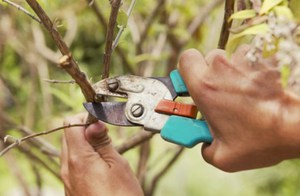
In the spring, it is necessary to trace how the plant develops: so that the crown is properly formed, it is not allowed to thicken the bush. Branches with a direction inside the bush, you must remove.
Before starting the process, it is necessary to prepare in advance all the necessary materials and visually examine the process of spring cherry trimming on video. So, you protect your plant from the wrong haircut and form a good crown. Cherry will thank you for a rich harvest.
Spreading branches of flowering cherry are a charming decoration of any garden. A variety of varieties will please even the most demanding grower. Interestingly this tree is also a form. It can be represented as a stately tree or a spreading bush. In order for the cherry to please not only with its shape, but also with its abundance of harvest, it should be carefully and carefully looked after. Care mainly includes annual pruning.
Crop of a cherry tree: why, how and when
The correct pruning of cherries in the spring is extremely important for the health and vitality of the plant. Photos of the process, posted later in the article, will demonstrate everything visually. This procedure allows you to create the correct form of the crown, inside which the air will circulate well and into which enough light will penetrate to ripen the fruit. The crown can begin to form in the fifth year after planting.
Being a heat-loving culture, cherries do not tolerate frosts and pruning procedures well, so it is better to start later, for example, in the second half of March, when the possibility of frosts returning is minimal. But the terms are variable depending on the climatic zone. A prerequisite is the start of pruning before the start of the sap flow process.
First of all, dried, diseased branches, which can infect the whole tree, and damaged, “drinking” nourishing juices, are pruned. All cuts should be smeared with garden pitch or ointment for pruning, but not on a bitumen basis. The processing process depends largely on whether you grow a bush tree or tree cherry in your garden.
Pruning spring cherry tree

The processing of cherries is complex, painstaking and requires careful.
- The first level of branches begins at a distance of 70 cm - 1 m above the ground. The branches below are deleted.
- Trimming is carried out at an angle. Removes all interlocking branches.
- Special attention is paid to giving the crown a vase-like shape.
- Annual shoots are shortened weakly. This allows you to get a sufficient number of side branches and new bouquet twigs.
- The trunk height of 3.5 meters or more requires limiting growth vertically.
Pruning Cherry
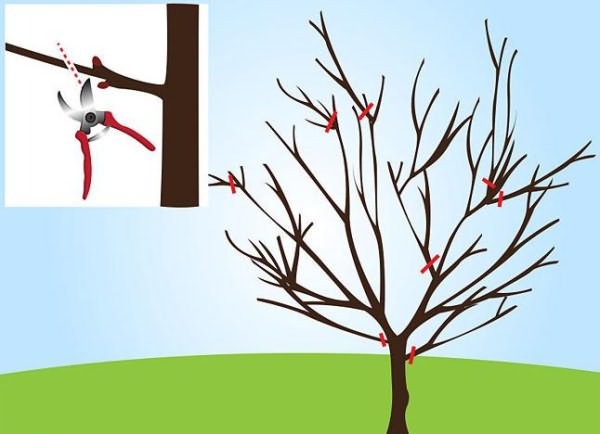
Requires ruthless thinning bush cherry. The spring pruning of trees of this variety has a number of features, since they are prone to thickening, which, in turn, leads to shallowing of the fruits and a decrease in yield.
- The lower branches must move away from the trunk at an angle of 40 degrees maximum, otherwise the tree may break over time.
- Creating a good, powerful skeleton requires trimming branches that compete with the main trunk.
- Two-year seedlings are pruned branches that have reached a length of half a meter. They can be shortened by a third.
- Removed all shoots growing to the ground.
- Semi-skeletal and skeletal shoots are shortened to dormant buds.
- You can leave shoots only in plants that have reached 80 cm in height.
- We work well sharpened tool.
The specifics of pruning young cherry
Pruning cherries in the spring when planting will ensure the formation of a strong, abundantly fruiting adult plant with a good crown and strong root system. First of all it follows:
- define a branch leader. This will be the strongest vertical branch;
- for the crown, leave 5 branches, located at a distance of 10 cm from each other and directed in different directions.
- branches, growing at an angle or diagonally cut;
- shoots located on the base of the trunk, remove to enhance the power of the entire tree;
- be sure to cut intersecting branches.
It should be remembered that bush-shaped cherries, unlike tree-like ones, bear fruit only on annual shoots, which means that pruning cherries in the spring should be more thorough. In general, pruning should be approached carefully and cautiously, as it is now that the growth and fruiting of the plant is being laid. Errors in the process can be a major cause of low yields.
Rejuvenation of old wood
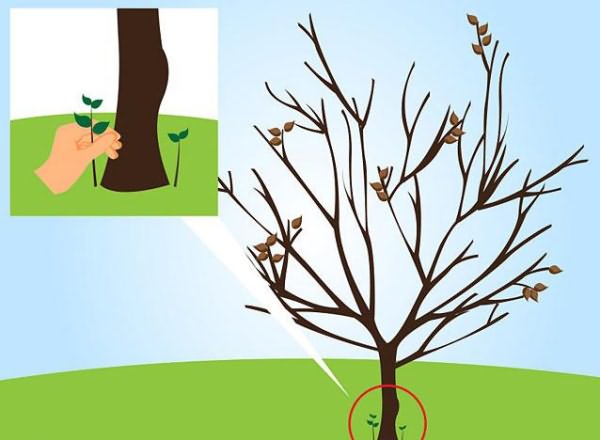
Phased process of rejuvenation and requires mature cherries. Pruning in the spring will provide increased yields. One common rule is for all cherries and tree and bush trees: do not remove many branches at once.
The bare ends of the branches of bushy cherries indicate the need for pruning. The number of branches is reduced by shortening the length of the shoot by half or one third. Skeletal and semi-skeletal branches should be removed to the level of dormant buds. They should be removed in different years, that is, skeletal branches are cut off in one year, in the other - semi-skeletal. Otherwise, the plant does not have enough strength for fruiting.
Tree varieties rejuvenate a little differently. Annual shoots are shortened quite a bit, because it is on them that the fruits will later appear. The crown should be rejuvenated if the bases of the skeletal branches are bare, and their annual growth does not exceed 15 cm. In the case of the branches drying out in the middle of the crown, the side branches should be cut off on five-year-old wood.
The specifics of trimming felt varieties of cherries
Felt cherry has fragrant, juicy and tender fruits. Fruiting begins the next year after planting. Productivity is high. All this is obtained with proper care and timely pruning. Pruning felt cherries in the spring should be made annually and be strong, as the crown of the plant is thickened. The harvest is mainly formed on the annual shoots, and their greater number will provide greater yield. However, they should still be shortened by a third if the length of the shoot exceeds 60 cm. Pruning cherries in the spring means removing all old, diseased, damaged, cracked or dried branches, as well as those that are directed inside. On old felt cherries, side shoots are removed on the ring, while the central part of the crown and peripheral skeletal branches should not be affected. After thinning should remain 12 strong shoots.

If you want a beautiful fruiting cherry to grow in your garden, pruning should be done in the spring taking into account the condition of the tree, its age and variety. A well-formed young trees will consistently receive a high yield of ripe and juicy berries.
fb.ru
Cherry gives incredibly tasty and valuable berries. Now cherry is widely popularized, there are so many varieties. To get a high-quality and high yield, it is necessary to carry out pruning correctly and in a timely manner. With the help of pruning, you can adjust the growth of the tree, the timing and amount of fruiting, etc.
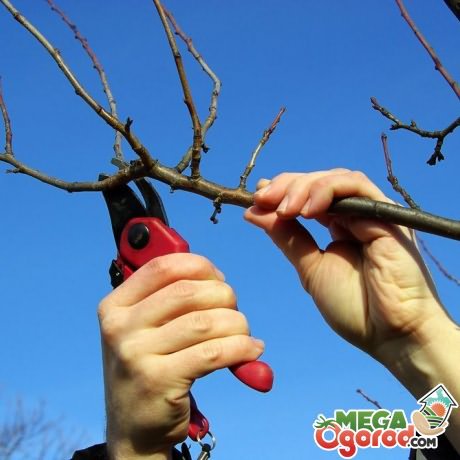
Cherry can be cut with the arrival of early spring in the event that the winter was relatively warm. Usually this time falls on the second half of March, when there is still a bit of snow, but there is no need to fear night frost.
If it is snowing or raining on the chosen day, it is better to refrain from pruning, because this will only complicate the workflow, and the wounds in the trees will be worse to overgrow. After an excessively cold wintering, pruning may not be carried out at all, or it may be done only after sap flow.
Pruning must be done before the kidneys swell too much.
Too late pruning will cause the loss of a large amount of nutrients, which will eventually lead to a weakening of the tree. In the event that pruning did not work in the early spring, then there is still a chance to fix everything in late May - early June.

Any culture has its own distinctive features of pruning, which is connected, of course, with the process of fruiting. Experts recommend pruning young cherry trees a year after planting. This will help the correct formation of the crown and prevent its thickening.
Branches that grow inward must be trimmed.
Young shoots appearing on a shtambe break off in the summer or a year later in the spring. To prevent the growth of the tree in height, shoots need to cut those that grow up. In varieties of cherries that grow with bushes, branches longer than 50 cm are pruned. In order to give the crown of the required shape, several side shoots are left on the main trunk. In order to prevent the need to trim the damaged and dry branches.
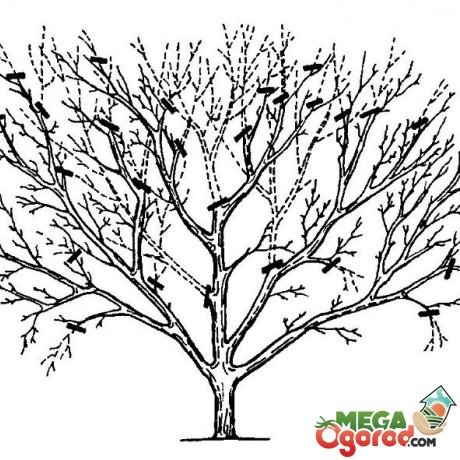
How to cut the cherry:
- Form a crown of cherries within five to six years after planting.
- Bush cherry cherry leaves about 8 main branches, tree - about 6. Considering the fact that the upper part of the trunk must be 20 cm higher than the tips of these branches.
- Branches that grow up, you need to cut in the place of branch, and leave directed to the peripheral part of the crown.
- The height of the trunk should be approximately 40 cm, since This is the most vulnerable spot for cherries.
- You can shorten growth only in young trees up to three or four years. Overgrown root shoots cause a weakening of the fruiting, so it must be periodically removed, but only in grafted trees.
- Trees in the fruiting period, taking into account the good growth of the shoots, can only be thinned, cutting the extra branches into a ring.
There is such a thing as "anti-aging pruning", which means cutting branches while reducing growth to 15 cm. The main branches must be shortened above the first lateral branching. It will take a more serious pruning, if the growth of branches ended about two or three years ago ..
Such branches are cut to the place where the growth of the lateral branches ended. In order to prevent gum therapy, you need to clean and wipe the resulting wounds with garden pitch. You also need to remove hemp in place of the cut branches, otherwise they can slow down the healing of woody wounds.
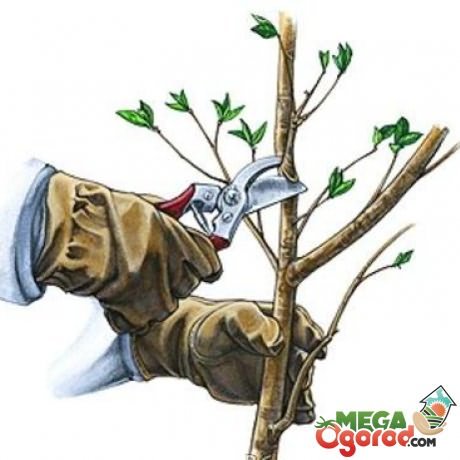
Young cherry is cut immediately after planting, which will help the grower to create the necessary crown shape, as well as help the roots to transfer the planting more easily and adapt to the new site, because remote branches do not need to be supplied with useful substances. Planted seedlings and remove the branches must be before the formation of buds. Seedlings pruned so that they remain about five well-developed skeletal branches.
Unnecessary growths are cut off, and the wounds on the trunk are covered with oil paint or, as stated above, with garden pitch.
Uncut branches should be 10 cm apart. In the spring it is necessary to ensure that the shrub is not overgrown, and the crown is properly formed. Branches growing inward must be removed. Shoots growing on the headquarters should be cut.
To control the growth of young trees need to shorten them from above. In shrubs, it is better to remove shoots longer than 50 cm. During the entire growth of the cherry tree, new branches should be left until there are more than fifteen of them. Pruning should be done very carefully and carefully, otherwise you can harm the future growth and fruiting of the tree. Any negligence and error can lead to lower yields.
Old trees should also be cut in a special way:
- They are cut for rejuvenation and increase in yield.
- It will be necessary to rejuvenate the formation of crown shrubs in the event that the branches become bare, and the tree begins to bear much less fruit.
- Productivity is restored by reducing the number of branches and shortening them by one third or half the length.
- In addition to shoots need to remove the main branches to the place of formation of buds.
- Skeletal and semi-skeletal branches must be removed in different seasons, otherwise you can significantly weaken the tree and reduce yields.
- One-year gains are strictly forbidden to cut.
Pruning a tree variety with a rejuvenating goal is done in a completely different way. Annual shoots are shortened a little bit, due to which new branches and lateral ramifications grow, which will also bear excellent fruit. It is necessary to rejuvenate the crown if the skeletal branches are bare at their base.
An old cherry cannot be cut off too many shoots at a time during pruning, it should be done in several stages and over several years.

Felt cherries must be cut annually. This is explained by the fact that it is this culture that is distinguished by its ability to quickly thicken. Most of the crop is produced on annual shoots, because shoots that are 60 cm long are cut off by one third. When cutting branches, you need to leave about 15 well-developed shoots. Old, damaged and damaged branches should be removed.
The rejuvenating pruning of perennial shrubs of felt varieties allows for a great harvest throughout the life of the cherry.
Some gardeners still believe that pruning cherries is a useless activity that will only harm the tree. And others generally believe that it will reduce the harvest. But all this is completely wrong.
Pruning trees is a must, it will only help him grow and develop better. And the subtleties of this process should know every self-respecting gardener.
More information can be found in the video.
MegaOgorod.com
Crop pruning: increase yields with a haircut
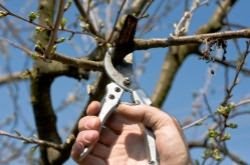 Pruning cherries is an important part of proper care. Pruning cherries is an important part of proper garden care. Despite the widespread opinion of the traumatic factor of pruning, cherry trees need to be formed, and it should be carried out in accordance with the basic rules and requirements.
Pruning cherries is an important part of proper care. Pruning cherries is an important part of proper garden care. Despite the widespread opinion of the traumatic factor of pruning, cherry trees need to be formed, and it should be carried out in accordance with the basic rules and requirements.
General requirements
Beginning gardeners very often make mistakes during pruning, as a result of which the tree can weaken and endure the winter period and even die.
The need for pruning
There are several goals for which pruning is carried out, but they all suggest improving the condition of the cherry tree:
- correct formation of the crown of the plant;
- extension of the period of fruiting;
- preventing depletion of cherry wood;
- reducing the risk of pests and diseases;
- achieving a well-groomed and neat appearance of the plant.

After pruning, a cherry tree redistributes a significant part of its vital forces to the formation of a crop that becomes more qualitative and stable.
So, with the observance of the rules of pruning, which should take into account the peculiarities of plant growth and the level of its fruiting, this event contributes to improving the viability of the tree and has a beneficial effect on fruitfulness, extending the indicators of the productive period.
Tool
To carry out this procedure should be used:- garden knife, necessary when cutting thin branches;
- a saw for cutting large branches of a tree;
- garden pruners.
The entire instrument should be kept clean and as sharp as possible. In addition, during the work, you will need to use a garden pitch, which is used to process all cutting sites.
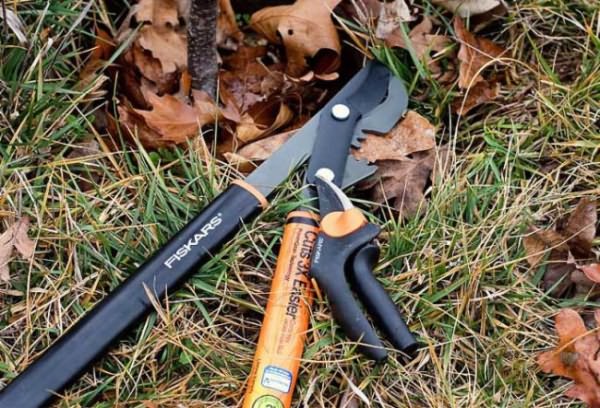
Features pruning bush and tree cherry
Bush varieties form the bulk of flower buds on annual growths, and with age, these branches become thicker and sag. Tree cherries form the bulk of the flower buds on the bouquet twigs, who can live for more than five years, but in conditions of the middle zone of our country, as a rule, they freeze out at an earlier date.Spray Cherry
When the end part of the branches is exposed, it is required to shorten them by a third or half of the length of the shoot, depending on the size. Skeletal and semi-skeletal branches are shortened to the lateral branch, which is characterized by good development and growth in the upward direction. Allowed pruning to the level of sleeping buds.
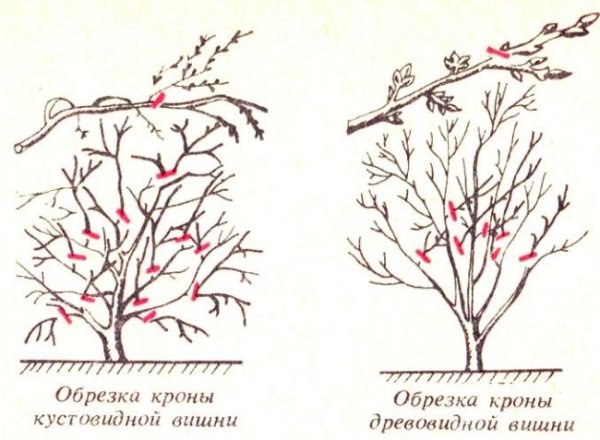
Pruning of skeletal and semi-skeletal branches alternate by year, which will allow the plant to transfer the procedure more easily. The resulting annual increments are not subject to removal. To increase branching, it is necessary to cut off the shoots that are longer than half a meter. Trimming to the side branch is more effective, rather than circular.
Tree cherry
In addition to thinning thickened crown, correct pruning removes the fork, and also contributes to the strengthening of the fruit branches and the formation of the subordination of the branches. Extremely long branches are subject to shortening.
When reaching one-year increments of 15 centimeters in length and exposing the base of the skeletal branches, the anti-aging pruning for five-year-old wood is made. Pruning restricting the growth of the tree is done when the plant reaches a height of 3 meters. In this case, pruning is effective by transferring the main and skeletal branches to pronounced side branches.
How to cut cherry in spring (video)
Features pruning fruiting and old cherries
When performing pruning, it is very important to focus not only on the type of plant, but also on its age characteristics. Attention and timely shortening of the branches require not only newly planted plants, but already old ones that require rejuvenation.
Young cherry
The basis for trimming young cherries is to form the correct crown, and the prevention of excessive thickening, which requires pruning of branches growing inward. Ensuring proper growth from the first year contributes to the uniform development of the tree and reduces the risk of problems with fruiting. At this stage it is important to identify the skeletal branches.
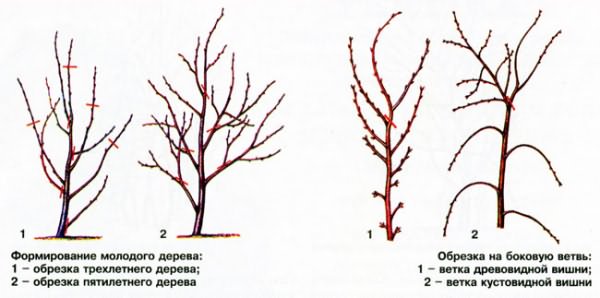
Old cherry
Old trees need careful care and rejuvenating pruning. On such plants is required to prune all the old and no longer fruiting branches. Sore branches require special attention, which should be cut to healthy wood. If there are branches on the old cherry that are strongly inclined downwards and have a low level of nutrient intake, then they should also be removed.
Fruiting cherry
When pruning fruit-bearing cherry trees, you should reduce the length of bare branches, as well as shorten the path of nutrient inputs from the roots to the crown. Developed annual growths are cut minimally.
- When pruning a fruit-bearing tree cherry, the growing branches should be directed outwards. Strongly contiguous branches need to be diluted by cutting over the side branches. With a strong exposure of branches, pruning of skeletal ramifications should be maximized.
- With a decrease in growths on the skeletal branches of bushy fruit-bearing cherries up to 20 centimeters, a continuous exposure of the branches is observed, which requires a weak rejuvenation in the form of partial pruning of skeletal branches of the first and second orders. At the same time, it is necessary to thin the crown as much as possible by cutting the thickening branches.

With a well-formed crown, the fertile value of the exposed end parts of the old branches becomes insignificant and the main yield is observed on the branches of renewal.
When prune cherries
Equally important are the timing of the cutting of cherries. Spring pruning allows the tree to quickly move away from the winter period of rest, and carrying out the procedure in the autumn helps the plant to prepare for winter. The scheme of pruning cherries in the fall and spring has insignificant differences.
Scheme pruning cherry autumn
Terms of pruning may vary depending on the region of cultivation. In the southern regions such work is allowed until the last decade of October. In the northern region to finish all work on pruning should be in mid-September. The main indicator is the stage of slowing sap flow of cherries, which characterizes the end of the growing season.
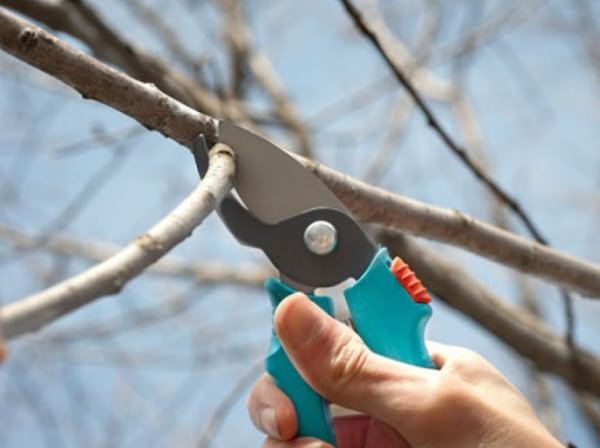
The standard autumn pruning scheme is as follows:
- Trimming all large branches that interfere with the normal development of the rest, except for the crown-forming skeletal branches. A remote branch should have a replacement, which will increase the rejuvenating effect and will not adversely affect the yield of the tree.
- It is necessary to remove all branches extending from the stem at an acute angle.
After completing the autumn pruning, all cut areas should be thoroughly treated with garden pitch or other special means.
Cherry Spring Cutting Technology
Spring pruning is key to plant formation. The annual execution of such pruning in April allows you to get a richly fruiting and beautiful tree.
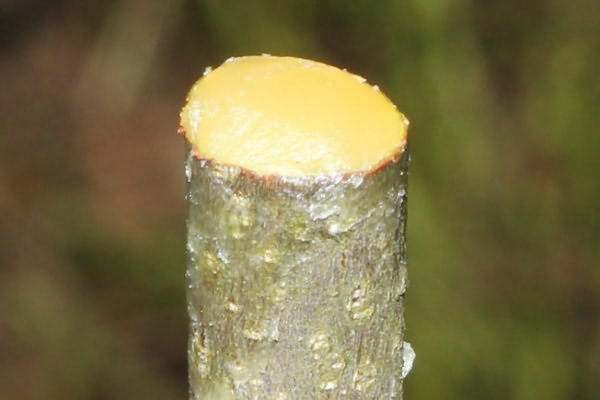
The standard spring pruning scheme is as follows:
- Removal of all branches that thicken the crown of a tree except for parallel branches to the soil.
- Removal of branches that prevent the full development and growth of the rest.
- If the main trunk rises above the frame branches by more than 20 centimeters, then it is necessary to trim it.
Pruning should be completed before the period of active sap flow. Special attention is required pruning felt cherries, excessive thickening of the crown which has a negative impact on the yield of the plant.
Care after trimming
Not later than a day after pruning, all sections should be thoroughly treated with antiseptic preparations, covered with oil paint or garden pitch. As a rule, no peculiarities in the care of cherries after pruning are required.
Autumn Pruning Cherry (video)
DachaDecor.ru
Handmade cherry pruning scheme | Homemade, crafts for the garden, do it yourself
Cherries, like other fruit trees, need periodic pruning.
Everyone knows that they produce this procedure in the fall and spring.
But, it turns out, the stone fruits, to which the cherry tree belongs, are also cut in summer. How and why to do it?
Types of pruning
- non-selective pruning;
- selective processing.
Thinning is to remove the entire branch entirely. Such processing makes the trees more compact, but is not accompanied by regrowth of young top branches, from which you can get fruit branches. Used infrequently.
Non-selective pruning of cherries consists in cutting a branch over any bud. It is produced in order to get young fruitful shoots. They grow from the buds under the pruning place. The growth direction is determined by the kidney, which is under the cut. The size of the tree with such pruning is not reduced, but it becomes more fluffy.
Selective pruning is to remove parts of branches selectively. Usually make a cut over the side branch. Its diameter is two times smaller than the diameter of the shoot, which is removed. Thin branches are cut to the bud. As a result, the height of the tree decreases, it becomes thicker.
Cherry is cut, leaving no stumps, in the place of which hollows may later be formed.
Why carry out the procedure
Cherry itself is not very tall and quite fluffy. Maybe it shouldn't be cut off at all? It turns out that cherry is a short-lived plant. She begins to bear fruit early, but quickly grows old. The tree lives about 15 years. Then it stops producing and the whole cherry dries. Care and cultivation, pruning aims to ensure that the tree lived and fruited as long as possible.
There are different and rather contradictory opinions about the results of the cherry pruning. Some gardeners are her opponents. Others believe that the harvest after the procedure increases several times. And finally, there are gardeners who argue that if the cherry is properly cut, it will produce fewer berries, but it will live longer.
Undoubtedly, it is necessary to form its crown correctly from the beginning of the life of a cherry. The berries on this tree grow large and tasty.
Pruning helps to get rid of sick and infected branches. Together with them a large number of pests are removed.
Spring cropping
Pruning cherries in spring is very important. It starts in April when the kidneys swell. Then it becomes noticeably frozen branches that need to be removed. But you need time to active movement of juices. Otherwise the tree will be weakened.
Such scheme of cutting of a cherry is usually used. Remove branches, thickening crown, and those that grow inside. They are removed completely. After pruning, the tree should have only branches located horizontally or at an angle of at least 45 degrees. After all, those that grow under more acute, often break off from the severity of the fruit.
Shorten the shoots, the length of which is more than 30 cm. Remove the branches that hinder the growth of others. Then shorten the trunk so that it is 20 cm higher than the side branches.
All these procedures must be done before the onset of active sap flow. Otherwise, the tree will weaken and become sick.
Anti-aging pruning
Cherry pruningThe branches of which grow less than 20 cm over the year are called rejuvenating. Such branches become bare and no longer bear fruit. In addition, the tree becomes less resistant to winter frosts.
Anti-aging pruning may be weak, medium and strong.
To make a weak rejuvenating pruning, cut growth for the last 2 years. For moderate clean branches that have grown over 4 years. With a strong anti-aging pruning remove growth for 6 years.
Remove all weak or branchless branches. The rest must be cut to the first strong branching.
After such a strong pruning a large number of young strong shoots will surely appear. But they do not need so much. Therefore, in the summer the extras are removed. In addition, they all usually grow vertically.
In order to change the direction of their growth, it is necessary in the summer to bind the left top, carefully take it as far as possible from the conductor and fix it in this position, tying the rope to a peg in the ground or another object.
Felt (bush) cherries in the first year are cut to 50 cm. In the second year, a quarter of the side branches are removed.
Flower buds are formed from felt cherries at the ends of last year's shoots. Vegetative plants are also formed there, from which leaves grow. If the tree is weak, the branches sprout up to 20 cm, then only flower buds are formed. Leaves grow nowhere, and in summer the branches remain bare.
On the annual shoots up to half a meter, almost all the buds are vegetative, so the yield on them is small. The optimal length of branches - up to 40 cm.
Thickened crown adversely affects the yield of the tree. Therefore, when pruning leave only strong branches. They are shortened to 10 cm. The rest are removed completely.
Felt cherries, like all stone fruits, are pruned twice a year. Her pruning in the fall is carried out at a time when the growth of shoots has already stopped, and the frosty weather has not yet arrived. If in the spring the young shoots on some branches do not grow, then the bush is cut off strongly enough. In the summer, all parts of the plant infected with a monilial burn are removed and burned. These are the branches, on which after flowering for some time all the leaves have blackened and fell off. If this is not done on time, they will soon grow back and it will be difficult to distinguish them from healthy ones.
Pruning cherries in summer. Scheme. The main features of the procedure
The summer pruning scheme takes into account that removing the main (skeletal) branches during a hot season is not very beneficial for the health of the tree. Wounds will be delayed for a long time. But pruning cherries in the summer is still carried out. It includes crown correction and removal of diseased and broken branches.
If the crown of a tree is formed correctly, it abundantly bears fruit and gives increments of at least 30 cm. It is a properly developing cherry. Pruning and care in the summer consists of pinching unnecessary shoots. All main branches of the crown should be directed outwards. Those that grow inward, you can try to send in the right direction. To do this, they are pruned above the kidney or branch, growing away from the trunk. But this is not always possible. In this case, these branches are removed completely.
Ensure that all branches are well lit by the sun as much of the day as possible. This will improve the quality of the fruit and allow more flower buds to form. It is the shortening in the summer of annual shoots of tree-like cherries will allow you to get them as much as possible. A fruit branch will grow from each bud below the cut.
Pinching young shocked shoots is easily tolerated by a tree, does not leave wounds, so you can perform it all summer.
At this time, remove the broken branches. If the cherry is very “curly”, then thin it out. You can break out young shoots, thickening crown.
Particular attention is paid to combating various diseases. Pruning cherries in the summer involves removing diseased branches. They are cut and burned so that the causative agents of ailments do not hit the other trees in the garden. This is the main reason why cherry is pruned in the summer. The scheme of the formation of the crown and bush is to reduce the height of the tree, rejuvenate the branches, the crop was stable.
Pruning in the fall
In the fall, the cherries are cut so that it can withstand the harshest winter frosts with minimal losses. But it must be done correctly. Otherwise, the plant may not survive the winter.
The timing of the autumn pruning depends on the region. In the south, you can cut the cherry in September and October, in the northern areas - in the first half of September. It depends on sap flow. It should be completed at the time of pruning. But to delay with this procedure is impossible. After all, loose wounds can lead to the drying of the branches.
Pruned in the fall of large non-skeleton branches, thickening the crown. Also remove those that grow at a right angle to the trunk.
Protection of the cut point
All wounds are treated with garden barb. No less effective, and other similar means that will protect them from frost. Their use is mandatory.
Pruning seedlings
Young trees-yearlings for the winter is not pruned, so they do not freeze. For the next few years, a saw or sharp knife is used for cutting. When working with shears, it is easy to damage the soft and soft bark of the tree.
In spring, young saplings are pruned later than old ones. After all, they still do not have fruit buds, which, in the stone fruit, bloom much earlier than the leaf ones.
For the formation of the crown choose 6 branches, which will later be the main. The distance between them should be from 8 to 15 cm. All the rest are cut out completely on the ring. The branches directed inside the crown are removed. If there are two parallel shoots, then leave one of them, the one that is located at a less acute angle.
An adult cherry tree should have no more than 10 main branches, a felt bush - up to 15.
The growth of the cherry breadth is not limited. The crown is thinned for easy care and harvesting. It is better to limit height from the same considerations.
Trimming features
Different types of cherries are cut in different ways.
In treelike cherry fruits are formed on fruit sprigs. They live and bear fruit for several years. They can be distinguished by their appearance.
Flower buds are bigger and rounder than vegetative ones. Often they are located with a halo around the apical bud. Then a new sprout grows from it, on which flower buds form.
The tree cherry, which has not been cut for a long time, is treated carefully, gradually bringing its height to three meters. If you cut all the branches at once, the tree will hurt.
Much better tolerated pruning felted cherry. Care and cultivation, pruning of these bushes are very different from those for the tree.
Trees more easily tolerate radical pruning, but their branches are still shortened in two sets. One year cut frame, the next - minor. Young fruit trees are not removed to get a harvest on it.
For the year, cherry branches should increase in length from 25 to 50 cm. If the tree is not cut at least a year, the harvest will decrease significantly.
But if for several years in a row it is correct to carry out this procedure in the spring, then the autumn pruning of the cherry may not be necessary.
Each deleted diseased branch is replaced by another. This allows you to rejuvenate the tree and get a good harvest.
handmade-garden.ru
Cut the cherry in spring, once a year
If even a super-yielding and large-fruited variety has been planted, without pruning the tree will never give the result you expect.Therefore, experts can not understand why many gardeners ignore this, in general, not
Very complex, but necessary method of increasing fruiting.
Cherry enough to trim once a year. Do it in the spring before the awakening of the kidneys. If there is
The fear that the tree froze in the winter, pruning should be carried out later.
When the kidneys go to growth and the frozen ones will be easy to see, then they start pruning,
At the same time deleting branches affected by frost.
In order for all parts of the tree to be open to the sun, it is necessary to properly form the crown.
Form the crown of the cherry when and how
Crown formation in cherries is made within 5-6 years after planting.In bushy varieties of cherries in the crown leave 7-8 skeletal branches, in tree cherry -5-6.
At the same time, the central conductor (the upper part of the trunk) should be 15-20 cm higher than the ends of the skeletal branches.
Branches growing up, cut off at the place of branch separation, leaving the crown directed to the periphery.
The shtamb (part of the trunk to the first skeletal branch) is the most vulnerable spot of the cherry because of its
The height of trees growing in the middle lane should be 30-40 cm.
The shortening of annual increments in cherries is carried out only in the young (three and four)
Age With a length of annual branches of 50 cm or more, they are shortened by a third for better branching. Annual twigs in fruiting bushy varieties are not shortened so as not to cause desiccation.
Grafted trees systematically remove root shoots, causing weakening
Fruiting. When forming the height of the trees limit 2-2.5 m.
In fruit-bearing trees with good growth of annual shoots (30-35 cm per year) are limited
Thinning, cutting branches thickening crown on the ring.
With a decrease in growth of up to 15 cm, the beginning of the exposure of the branches make rejuvenating pruning.
Skeletal branches shorten over the first lateral branching on the growth of the last year. With
Severe exposure, when branching stopped 2-3 years ago, we need a more cardinal pruning.
Skeletal branches are shortened to the point where the formation of lateral ramifications has disappeared.
But rejuvenating pruning (especially for trees that have not been pruned for several years)
One year, and for 2-3 years, otherwise the cherry can cause gum treatment.
Also, so that it does not
To provoke, the wounds after trimming are cleaned and covered with garden pitch, oil paint. When cutting the damaged branches you cannot leave hemp - this prevents the healing of wounds.
Root-own cherry, in which the branches begin to dry, is rejuvenated by root
Siblings.
To do this, leave the 2-3 most branched and pruned form of new branches.
A few years later the cherry turns into a bush with uneven-aged trunks coming from the ground. In the future, each of them is cut in accordance with his age.
Anatoly Mikheev, candidate S.-H. of science
Continuation of the article ...
- How to protect cherries from pests and diseases
bestgardener.ru
Is it possible to rejuvenate a 20-year-old sweet cherry?
Valery Svistunov
For one year, pruning apparently will not work. But cut it off too much, how frightened you are here - don't worry. Verified Several times I tried to completely remove the trees, not only the sweet cherry. He left a tall stump that would tie a newly planted tree to it. On the stump was not a single twig. And suddenly, from where not to go in the summer, 2-3 crawled out, and then more new branches. As a reward for such persistence had to leave them. Some pereprivivat other varieties. Pereprivit several branches and you need - other varieties. Then it will not be necessary pollinators. All stone fruit needs annual pruning. They love it or not "love". Otherwise, the thickening of the crown and as a result of the disease. If every year - then you can do a simple nip. There is no control over clipping if everything is done correctly. Cover all the cuts carefully. Thinking occurs for other reasons. With careless pruning course too
elena orlova
Anti-aging pruning is a type of pruning for perennial wood, and it is used in the case when other methods of pruning, fertilizer and watering can not achieve gain growth. Old trees with bare skeletal branches and forks and a large number of shrunken, weak overgrowing and semi-skeletal branches can still be made to give good yields. However, before doing rejuvenation, trees should receive good care in a year - abundant fertilizer and regular watering. Rejuvenation gives a good result if the tree has a healthy, not damaged stem. The degree of anti-aging pruning depends on the condition of the tree. Science recommends rejuvenation in stages, for 2-3 years. They begin pruning with a strong thinning of the crown, cutting out all thickening, crossing and overlapping branches, shortening them by 1 / 3-1 / 2 length. Pruning is carried out on an 8-10-year-old wood above the branch more flatter and located in the crown. Even if such a suitable branch is not found, it is cut all the same, hoping to get shoots at this place due to the reserved sleeping buds. Cutting, shortening, do not forget to maintain the subordination of individual branches. The fouling branches thin and shorten. Due to the rejuvenating pruning, the ratio between the aerial part of the tree and the root system changes. More nutrients are supplied to the trimmed branches. In this case, there is an increase in growth, and in large numbers the tops grow, they are sent to the right places of the crown and rejected or slightly shortened. After 2-3 years, the rejuvenated trees restore their crowns and begin to give normal yields. A strong rejuvenating pruning, in which skeletal branches are shortened to 6-8-year-old wood, is severely thinned and the overgrown wood is shortened, more effective compared to a weak rejuvenating pruning. Usually, only after 4-5 years, the effect of rejuvenation appears after it. Rejuvenating pruning - shock pruning for any plant. Therefore, the gardener must perform it step by step, in a timely manner to gloss over the cuts with garden pitch
Sergey Kostenko
20 years for the cherry blossoms are the most flourishing, and at this age not rejuvenating is needed, but also simply formative ... but a few subtleties
- she has a lot of usually sharp corners that break, and start with them
- Cherries like all stone fruits do not like pruning, so little by little and for a few years is necessary ...
- in principle, the normal growth of cherries just from meters 5-6 or more, well, it will not be possible to keep it at a lower height ...
Elena the Wise
For the correct formation of the crown of cherries, it is necessary after the appearance of branches of the third order to trim the top. If such a moment was missed, then it is necessary to reduce the crown now. For pruning a tree, it is better to invite a specialist, since the cherry is allowed to rejuvenate the 5-year-old wood. Do not spend a strong thinning of the crown and shortening the branches, so that the cherry is not ill with cicatrix.
Nikolay Tsuprunov
If the tree is great then this event will prolong its life and fruiting period.
For many novice gardeners, the question of cutting cherries leads to a state close to a stupor. Immediately the questions begin: do the cherries do pruning? The trees seem to bloom well without it. And if after abundant flowering the harvest was not very good, then the gardeners, without thinking, explain this by the fact that there were many barren flowers among the flowers, but is this true?
By no means. The fact is that the buds are simple and are either flowering or deciduous. At the same time, flower buds awaken much earlier than deciduous ones, which creates the illusion of a crown completely covered with flowering.
More experienced gardeners may notice that cherry care and pruning are two different things, since removing the branches causes gumming, which will subsequently harm the plant. Such a scenario is quite real if it is greatly weakened. But if the tree is healthy and does not freeze over in winter, then the correct pruning of the cherry will only benefit him.
In cherry planting, care and pruning should be made according to a well-thought-out scheme, preventing growth on gravity. Indeed, despite the difference between bush and tree species, flower buds will be formed mainly on annual branches. At the same time, if the annual growth is 0.5 m and more, then the buds will be vegetative and then new branches will be formed. Too short shoots, on the contrary, will be dotted with flower buds. Both of these options are unsuitable, so the gardener will need to artificially adjust the length of increments in the range from 0.25 to 0.5 meters. Only such growths will bear fruit this year and set the basis for a good harvest in the next.
When to prune cherries, time, dates?
Terms of pruning cherries are somewhat different from the similar care of apples and pears. The fact is that this culture is thermophilic and it endures frosts worse, so the time of cherry pruning in the spring falls in March, when the risk of frost is much lower than in February. In the summer, processing can be carried out either together / immediately after harvesting. If the plant is sick, then carry out the so-called sanitary pruning, for which there is no special time limit. With this type of cherry care, the most important thing is to quickly remove diseased branches, which can later infect the entire tree or even the garden.
In the fall, a suitable time to care is considered the period of the end of the growing season. It is desirable that the weather at the same time was quiet and clear, otherwise there is a risk of gum formation.
A gardener should understand that there are no strict deadlines for pruning cherries and other fruit trees. The main landmarks are made on climate, soil fertility and weather forecast for the coming days. For example, if experts recommend autumn care after the leaves have fallen but no frost, and weather forecasters promise a sharp drop in temperature to -15 ° C, all manipulations that do not require urgent intervention should be canceled.
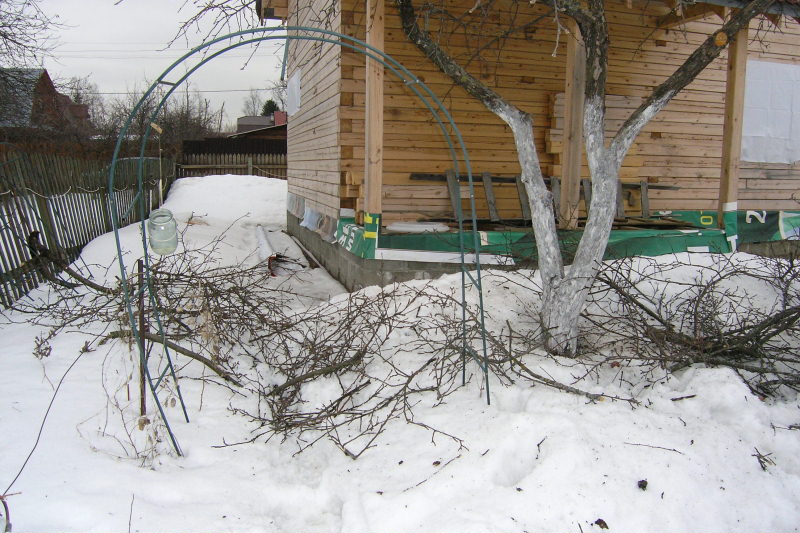 Pruning cherries in the spring is the most important and solid event. If the gardener does everything correctly and adheres to the same scheme of actions for several years, in most cases only one spring care per year will be enough.
Pruning cherries in the spring is the most important and solid event. If the gardener does everything correctly and adheres to the same scheme of actions for several years, in most cases only one spring care per year will be enough.
It is necessary to start correct pruning of cherries in spring before the buds start to awaken on it, and if the winter was very cold and there is a suspicion that some trees could freeze, then the branches should be removed after the buds grow. In this case, it is not difficult to determine which shoots are frozen and which are not. And then you can begin to form the crown, simultaneously removing the frostbitten shoots. The disadvantage of this method is the heavy tolerance of the received wounds by the plant.
If the length of annual shoots is 25-35 cm, then they are not cut, limited to only the removal of competing branches and shoots, thickening the crown. In this case, the growing branches are to be cut at the place of their discharge, and the peripheral ones are left. The last part of cherry care is shortening the conductor, after which it should slightly rise above the ends of the skeletal branches (no more than 20 cm).
Pruning a Cherry in the Fall
Pruning cherries in the autumn is used much less frequently than in spring, since many gardeners believe that they can thus harm the future harvest, because the wounds inflicted upon removal of branches make the tree more sensitive to winter frosts. But this is not the case; proper autumn pruning helps prevent the development of many infections, prolong planting life and increase future yield. Cherry, like other representatives of stone crops, needs at least two treatments a year - spring and autumn, so it is still worth preparing it for wintering.
It is necessary to plan the procedure of autumn care in accordance with the climate zone of residence. For warm regions, the last days of November may be suitable, and for cold regions - September 10th. The most important thing here is to catch the moment between the end of the growing season and the first frost.
It should be noted that the annual cherry saplings do not need autumn pruning, since the young, not large tree in the place of the cut can easily freeze out, which in no case should be allowed. For older seedlings, in the autumn, diseased and broken branches are removed, and only then they look to see if the crown needs a little adjustment, by shortening other plants.
Winter Pruning
In contrast to the common opinion among gardeners that cherry pruning is not carried out in winter, as this may destroy it, there is another opinion, which, on the contrary, recommends that work be done at the end of winter.
Pruning cherries in winter allows the gardener to be 100% sure that she is in a state of absolute rest, which means that wounds will be transferred more easily than in spring. However, it should be noted that the work cannot be done in severe frosts, as the bark becomes excessively fragile and can be severely damaged during the removal process. Also, do not forget that mature plants tolerate frost much better than young ones, which are not recommended to be removed in winter.
Otherwise, winter pruning of cherries has a number of advantages, among which it is possible to single out separately: lighter cutting of wood with a smooth cut, low probability of getting a teaser bark.
If the garden consists of cherries of different ages, then pruning should begin with the most mature and fruit-bearing trees, since the buds on them will wake up earlier than in young or old relatives.
The wounds inflicted during the formation of the crown must be thickly covered with garden pitch, thereby saving the bark at the base of the wounds from frostbite.
Summer pruning cherry
Summer pruning cherries in essence is an additional way to care for the crown in the process of its formation. Leaving the summer for the main work on shortening shoots and the formation of skeletal branches, it is extremely unwise. Firstly, it is extremely irrational: it turns out that the branches to be removed received nutrients from the beginning of spring and instead of accumulating forces and directing them to young shoots and fruit buds, the tree wasted them absolutely wasted.
Secondly, in summer the cherry growing season is at its peak, so it will immediately react to any wound. And insect pests, as well as various diseases of garden plants will be happy to have the opportunity to settle on them freely. Therefore, in the summer there are basically two reasons for removing branches:
- it is necessary to perform fine correction of the crown according to the previously selected scheme;
- there is an urgent need for sanitary cleaning of diseased branches, since there is a possibility of the spread of infection both in the tree as a whole and in other cherries.
Remember, sanitary pruning should be carried out as soon as possible after the detection of the problem area.
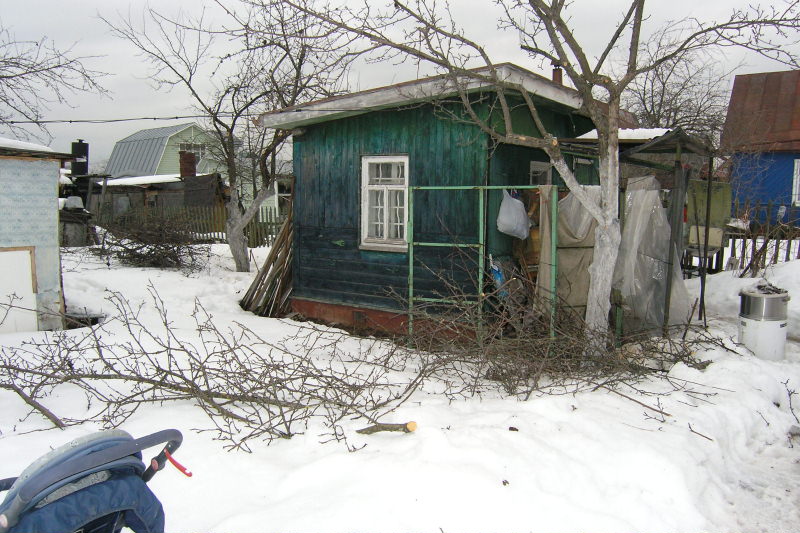 Pruning of old cherries has its differences for bushy and tree trees, but the common goal for them is to rejuvenate the tree and increase its fruiting.
Pruning of old cherries has its differences for bushy and tree trees, but the common goal for them is to rejuvenate the tree and increase its fruiting.
The fact that the rejuvenating pruning of a bush bush cherry will be necessary will be indicated by the exposure of the ends of the branches. In this case, you can return the yield by reducing the number of branches by shortening them by 1/3 or even ½ the length of the shoot. In addition to shoots, skeletal and semi-skeletal branches are removed to the level of dormant buds or to upward, well-developed lateral branches. In order for the plant to have the strength to bear fruit after the branches are removed, the skeletal and semi-skeletal branches are removed in different years, but you should not touch the annual growths that have appeared.
The rejuvenating pruning of an old tree cherry occurs somewhat differently: annual shoots are shortened only slightly, which makes it possible to obtain a large number of new bouquet branches and lateral branches, where later fruits will appear. Proceed to this rejuvenation should be when the skeletal branches are bare at the base, and the shoots for the year grow no more than 15 cm. In this case, shortening is possible to a length of up to three years old wood. If the branches growing in the middle of the crown have dried up, then the rejuvenating pruning of the cherry should be done on the side branches growing on the five-year-old wood.
When pruning both types of old cherries, there is a general rule: you can not delete a large number of branches at once! With a large amount of work it is better to plan for many years of staged rejuvenation.
Pruning young cherries
Pruning a cherry seedling immediately after disembarking makes it possible to form a form convenient for harvesting, helping, thereby weakening the root system of the tree transplanting process, it is easier to take root, since some of the distant branches will no longer need to be saturated with nutrients. It is better to do the planting and first pruning of cherry seedlings before the buds appear on the tree, this will enable it to get stronger before flowering and the period of active growth.
At the same time, five strong and most developed branches are left to the seedling, everything else is removed under the ring, and wounds are covered with garden pitch on the same day. Ideally, the left branches should be located at a distance of more than 10 cm from each other and be directed in different directions.
In the spring of next year, the gardener must ensure that the bush does not thicken, and the crown continues to form according to a given pattern. Therefore, all directed inside the branch, cut out. Shoots appearing on the trunk are removed in the summer or cut out the following spring. Young tree plants are pruned from above, thereby controlling the growth of the tree, and in bush plants they shorten shoots from 0.5 meters in length.
With the growth of young cherries, new skeletal branches are left to the tree, until their total number exceeds 15. Damaged and dried branches are removed.
By cutting young cherries should be approached with great responsibility, because in this period the nature of growth is laid and the mistakes made in this period can significantly reduce its yield in the future.
Features trimming felted cherries
In the felt variety, the main part of the crop is formed on annual shoots, so you should not be overly zealous with their pruning, but if the shoot has a length of more than 60 cm, it should be shortened by 1/3.
Felt cherry quickly thickens, so you need to thin out annually. It is recommended to leave from 10 to 12 strong shoots. All old and broken branches should be promptly removed. The rejuvenating pruning of felt cherries on the aging bushes will allow getting good yields for quite a long time. To do this, remove a few side shoots on the ring, without affecting the peripheral skeletal branches and the central part of the crown. Then it is necessary to carry out the treatment “for retreating growth” and, when from the sleeping buds located near the place of shortening, shoots appear, the old crown, which is located above it, should be removed.
In the studio of landscape design "Sovereign" there are specialists who have not only theoretical knowledge of pruning fruit trees, but also practical skills for its implementation. They are familiar with the features of this type of work and take into account the state of the tree, its age, varietal affiliation. Their high professionalism will allow to competently form young trees, as well as to put in order the adults, which will allow to obtain high and stable yields of tasty and healthy berries. We provide pruning trees and other gardener services not only in Moscow, but also in the Moscow region, and at competitive prices.
If you find an error, please highlight a piece of text and click Ctrl + Enter.
In order to tree regularly and abundantly fruiting, annual removal of dry, damaged branches. In addition, pruning cherries helps to form a correct, good crown. This work can be done in the fall and spring. Pruning cherries in spring begins before the buds swell. If the tree is damaged by winter frosts, this is done a little later, when the buds start growing, at the same time, the frostbitten shoots are removed.
Spring pruning cherry
Spring pruning of cherries falls in the middle of March - beginning of April, because this culture is thermophilic and does not tolerate strong frosts. If the plant is sick, you must remove the sick, damaged branches, which can infect healthy branches and the entire plant completely. Annual shoots that have reached 20-40 cm, do not cut. Remove neighboring competing branches, thickening and entangling the crown. The branches growing up, cut off in places of their discharge.
How to cut cherry in spring
Cherry cutting can be done once a year, if this work is carried out correctly. In order for a tree to be completely open to the sun, it is important to form a crown. Krona is formed 5 years after landing. If the tree has a bush form, 7-9 skeletal branches are left in the crown. A cherry tree has enough leaves 4-6. The height of the headquarters should be 30-40 cm. Annual gains are shortened only in young cherries that have reached the age of 3-4 years. If the length of the annual shoots reached 50 cm, they are shortened by 1/3, which contributes to better branching. However, annual gains in fruit-bearing varieties are not shortened, as this may lead to their drying out. In grafted trees, root shoots are removed, which reduces crop yield.
Fruiting individuals, having a good growth of annual shoots, do not need pruning, so they are only thinned. When growths are reduced to 10-15 cm, they make rejuvenating pruning. Skeletal branches are shortened to the point where the formation of lateral branches has ceased. Anti-aging pruning is carried out for 2-3 years, otherwise gum therapy may open at the cherry. Often, when branches are removed, wounds appear on the bushes, which are covered with garden pitch or oil paint.
Pruning Cherry Trees
Proper pruning of cherry trees is different from the usual removal of excess sprouts, which often leads to wounds and cicatrisation and may subsequently damage the plant if it is weakened. This work is quite complex, painstaking and requires carefulness, so before you start forming the crown, you need to study in detail information about how to cut the cherry in spring.
Pruning young cherries
Pruning of young cherries is done immediately after planting the seedling, which allows the gardener to form the desired shape of the crown, to help the root system more easily transfer the transplant and settle down in a new place, since remote branches do not need to be saturated with nutrients. Planting and removal of branches carried out until the buds. Sapling pruned so that it remains 4-5 strong, developed branches.
The remaining increments are removed, and the wounds on the tree are covered. Left branches should be at a distance of 10 cm from each other and sent to the side. In the spring, it is monitored that the bush does not thicken, and the crown continues to form correctly. All branches going inside are removed. Shoots, formed on the headquarters, cut out. Young, grown trees are shortened from above, controlling their growth. In bushy varieties shorten shoots exceeding 50 cm in length. As the cherries grow, new skeletal branches are left until their number exceeds 15.
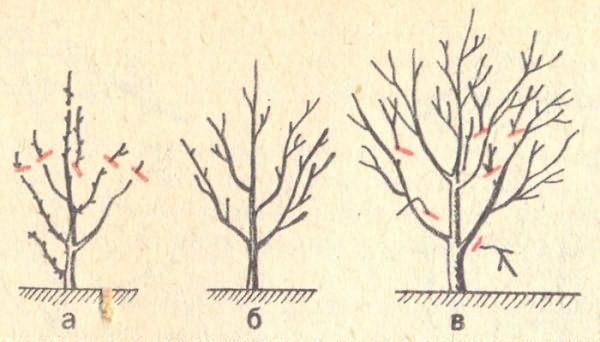
Pruning young cherries should be very careful since during this period the nature of the growth and fruiting of the tree is laid. Mistakes can lead to low crop yields in the future.

Pruning of old cherry trees also has its own characteristics. Conducted with the aim of rejuvenating them and increasing yields. The rejuvenating crown formation of bush varieties is required when the ends of the branches become bare and the fruit bearing of the tree is significantly reduced. Productivity returns, reducing the number of branches and shortening them by 1/3 or 1/2 the length of the shoot. In addition to the shoots, I delete skeletal branches to the level of the kidneys or to well developed lateral branches. So that the plant does not weaken after pruning and continues to bear fruit, skeletal and semi-skeletal branches are removed in different years. One-year increments can not be touched.
Anti-aging pruning of tree varieties is done differently. Annual shoots shorten a little, so that new bouquet branches and lateral branches are formed, on which fruits will later appear. Rejuvenation of the crown is required if the skeletal branches are bare at the base, and annual increments are less than 15 cm. When the branches growing in the middle of the crown dries, pruning is carried out on the side branches.
When cutting old cherries, you cannot remove a large number of shoots at a time. Such work is carried out in stages and lasts for several years.
How is cherry pruning in spring, you can see on the video:
Pruning a Cherry in the Fall
Pruning in the fall is carried out from September to November. In the southern regions, cherries are pruned after leaf fall. Young individuals are not recommended to be cut off after the first growing season, as their crown is just beginning to form, and young branches can freeze out in severe frosts. In the autumn, they remove large increments that hinder the growth and development of the tree, as well as thickening the crown. Autumn pruning is done every 3 years. This work should not be done immediately before the frost, it can weaken the tree and reduce its winter hardiness.
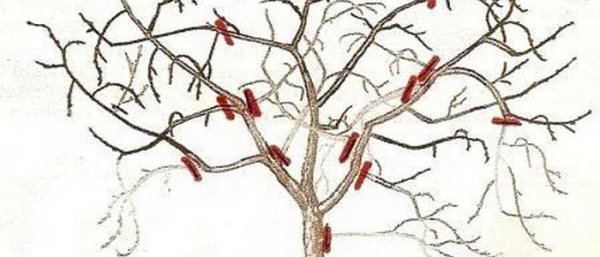
Pruning cherries in the fall is needed for prevention. During this period, dry, diseased, damaged branches are removed with their subsequent destruction. Burning the branches will save other trees from diseases and pests that are on diseased branches or in their foliage. Sections are treated with garden pitch or paint.
Many gardeners form crown cherries in the winter. At this time, the trees are at rest, so the wounds they heal faster and easier than in spring or autumn, in addition, the likelihood of a bully bark decreases in winter. However, in severe frosts, this work cannot be carried out, because the bark at this time becomes very fragile and can be damaged during pruning.
Winter pruning is suitable for adults who tolerate frosts better. The wounds that appeared in the process of crown formation are treated with garden pitch, which will save the bark at the base of the wounds from frostbite.
Felt cherry pruning
Felt cherry pruning is done annually. This is due to the fact that this culture, due to its characteristics, quickly thickens. The main part of the crop is formed on the annual shoots, so the escape length of 60 cm is shortened by 1/3. When removing branches, leave 12-14 strong shoots. All old, damaged and dried branches are deleted. The rejuvenating pruning of perennial bushes of felt cherries will allow to obtain abundant crops throughout the life of the tree.
udec.ru
Pruning cherry in spring: instructions with video
 Many people know that a regular and abundant harvest of cherry berries depends on the correct and timely cutting of the crown of the tree. As a rule, the formation of the crown of trees made to engage in the spring or autumn. Spring pruning of cherries allows you to free the tree from old, sick and broken branches under the weight of snow. However, it does not always remove only the old and diseased branches, sometimes you have to clean up completely fresh. What is it for? How to make pruning cherries in the spring?
Many people know that a regular and abundant harvest of cherry berries depends on the correct and timely cutting of the crown of the tree. As a rule, the formation of the crown of trees made to engage in the spring or autumn. Spring pruning of cherries allows you to free the tree from old, sick and broken branches under the weight of snow. However, it does not always remove only the old and diseased branches, sometimes you have to clean up completely fresh. What is it for? How to make pruning cherries in the spring?
The process of cutting cherries and cherries in the spring or autumn period requires great patience from the gardener and competent approach. Many gardeners are confident that pruning cherries is an unnecessary exercise, time-consuming, while the tree is already bearing fruit. This is an erroneous opinion, because besides getting a meager crop, ignoring the pruning of a tree, a gardener can lead a tree to death.
What is pruning cherry for?
Pruning a tree is necessary in order for it to have the correct crown. Without such a procedure, the tree will begin to grow in width, so that its branches and trunks will become weak and fragile - they will easily break from the wind and under the weight of snow. The formation of the crown, in turn, allows you to get a stronger tree with a strong trunk and flexible branches.
Haircut helps to reach the tree trunk plenty of sunshine, which has a beneficial effect on the growth and development of the plant. Airing the crown can be achieved only by freeing the plant from unnecessary branches.
In addition, it is necessary to cut the cherry in order to free it from old, sick and broken branches. They take a lot of nutrients from the tree, and there is no benefit from them. In addition, diseased branches can infect neighboring, and then the whole tree. A pruned tree gives a rich and annual harvest - another indisputable plus of this procedure.
How to prune cherry in spring?
Spring pruning cherry should start from mid April. This period can be changed depending on the climate of the area, but it is necessary to prune before the sap flow begins in the branches. Otherwise pruning can damage the wood. It is necessary to carry out this procedure correctly and according to certain rules - this will facilitate the gardener's work, make the process the most qualitative and harmless to cherry:
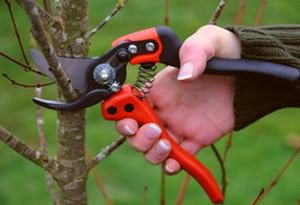
A haircut performed once a yearHowever, if necessary, it can be repeated in the fall. Formation of the crown should be done if after planting a tree 5 years have passed. When bushy cherry form, you must leave about eight skeletal twigs. For tree variety, leave about 5 branches. You can shorten only young cherries 3-4 years.
If the annual shoots reached a height of more than half a meter, they should be shortened by one third - this will contribute to their better branching. A one-year increase in the fruit-bearing variety does not need to be cut, as this will lead to the drying out of the plant. In grafted wood, it is necessary to remove root shoots that reduce its yield.
A fruit bearing individual, having a beautiful growth of annual shoots, does not need to be cut, it is only necessary to thin out the branches of the tree. If the gain has decreased by 10-15 cm, you can spend rejuvenating pruning. Skeletal branches must be cut to the place where the growth of the side branches stops. Such pruning should be held 2-3 years in a rowotherwise the plant will open gum.
If after removal of the branches, wounds appeared on the trunk, they must be processed. Use for this garden var or oil paint.
Pruning a young plant
Young cherries should be pruned immediately after planting. Pruning the seedlings will allow you to achieve the correct shape of the crown of the tree, the root system of the plant will transfer the transplant more easily, it will take root more quickly and easily in a new place. Pruning a young plant is necessary carry out the following rules:

In the spring, it is necessary to trace how the plant develops: so that the crown is properly formed, it is not allowed to thicken the bush. Branches with a direction inside the bush, you must remove.
Before starting the process, it is necessary to prepare in advance all the necessary materials and visually examine the process of spring cherry trimming on video. So, you protect your plant from the wrong haircut and form a good crown. Cherry will thank you for a rich harvest.
ogorod.guru
Care for cherry in the spring. Planting, feeding and pruning cherry
Planting cherries is easy, but in order for the tree to grow strong, healthy and give a rich harvest, you need to properly care for it. The care of cherries in the spring is very important, and it consists of several stages that will ensure the correct development of the tree and obtaining an excellent harvest.
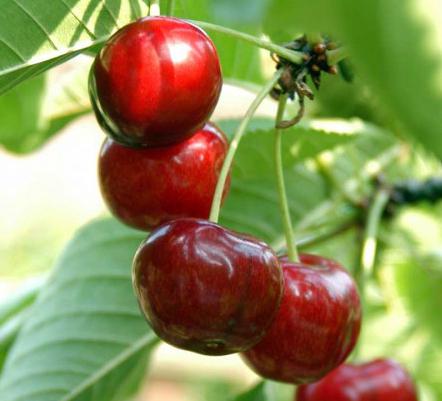
Planting cherry
First of all, it is necessary to determine the place where the tree will grow. Cherry is demanding of sunlight, so you need to choose a well-lit area on an elevation, protected from the cold wind. The tree does not tolerate the transplant, so you need to be very responsible when choosing a place for it.
Planted cherry in April, until the buds are full. Light loamy or medium loamy soil is preferred. To begin with, a planting pit is prepared, the optimum depth of which is 40-45 cm, diameter - 50-60 cm. A peg is placed in the middle on which the tree will rest. In the center an elevation is made of the soil mixed with fertilizers (humus, superphosphate - 30-40 g, potassium chloride - 20-30 g and 1 kg of ash). The seedling is installed strictly vertically in the pit, sprinkled with earth and compacted. Around the tree you need to make a hole for watering and pour into it two or three buckets of heated water. The land around the seedling is mulched with humus or sawdust.
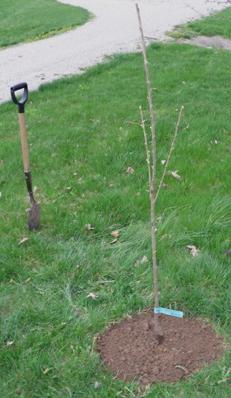
If there is still a need to transplant the tree, then cherry transplanting in the spring will be the most successful option, because over the summer the seedling will have time to get used to a new place and get well acclimatized.
Top dressing
Many gardeners are interested in the question of how to feed the cherry in the spring to add strength to the tree and get a good harvest?
The first dressing produced before flowering. Effective use of ammonium nitrate or urea, which must be applied to the soil in liquid form. Spraying does not bring much benefit, since it turns out that the branches are processed, and not the leaves, through which the trace elements are absorbed.
During the flowering period, top dressing is carried out by the root method using nitrogen-containing compounds. You can also use green manure or chicken manure. In order not to harm the root system, you must try not to exaggerate the dose of chicken manure.
After the cherry blossoms, fertilizing is done with organic matter: manure, compost or special organic mixtures. This ensures high-quality harvest.
Pest control
Caring for cherries in spring includes pest and disease control, which are activated at this time of year. Serious damage to your tree can cause cherry aphid, cherry moth, weevil, slimy sawfly.
The first processing of cherries in spring is made in late March or early April, until sap flow begins. Thus, all pests that survived the frost in the ground or in the tree are destroyed. In the shops you can find a lot of effective and safe means of pest control, the main thing is to follow the instructions in order not to cause harm to the tree.
Treatment of cherries in the spring for the prevention of fungal diseases is performed using copper sulfate or Bordeaux mixture. Means are safe for both people and fruits.
Whitewashing the trunk
In the spring, dry grass and garbage are harvested around the trees, and the soil is carefully dug up so as not to damage the cherry roots.
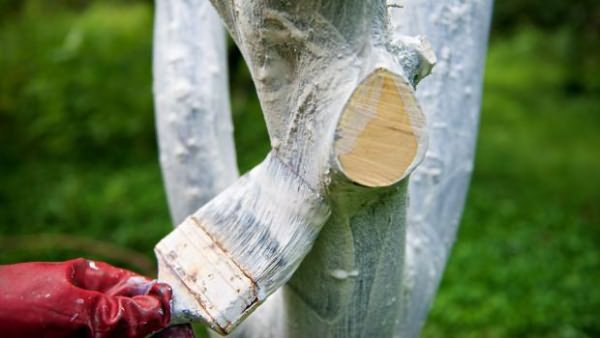
Spring whitewashing is done before the arrival of heat and the appearance of pests. It is best to do this in mid-March or early April. You can not whiten the trees in cloudy or rainy weather. Before whitewashing it is necessary to inspect the trunk of the cherry tree, clean off the old bark and moss from it. You can not use knives and brushes for this, so as not to damage the bark of the tree. Existing damage is smeared with garden pitch, after which the barrel is whitened using a spray gun or a wide brush.
Cherry pruning
Such care for cherries in the spring is necessary for the proper formation of the tree, increasing yields, improving the taste of berries. In addition, pruning is an additional protection of the cherry from pests and prevents the spread of disease. Cut all dried and damaged branches or pests. For convenience, when harvesting, pruned and branches that grow too high. In addition, the dried bark is also removed.
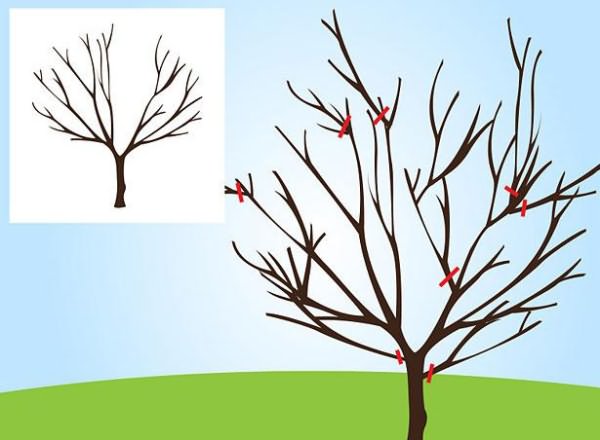
Cherry pruning rules
- Pruning cherries should be done the next year after planting, this ensures the correct formation of the crown and prevents its thickening.
- It is necessary to cut off all the branches that grow inward.
- The young shoots appearing on the trunk must be broken off in the summer or cut off in the spring of the following year.
- The pruning procedure is done before the kidneys swell. Removed dry and damaged shoots. After that, it is necessary to cover every wound with garden pitch.
- Bush varieties need pruning for branches longer than 50 cm.
- To form the correct form of the crown, as the tree grows, side shoots are left on the main trunk. An adult tree should have about 15 branches.
- When pruning old cherries, do not remove too many branches at a time.
Pruning a young tree
The scheme of cutting the cherry in the spring is as follows: 4-5 developed branches should be left, removing the remaining growths and smearing the wounds. The branches that remain should be located at a distance of ten centimeters from each other and look in different directions. In the future, it is necessary to monitor the correct formation of the crown. Shoots that go inside must be removed. It is necessary to carefully trim the sapling to avoid yields in the future.
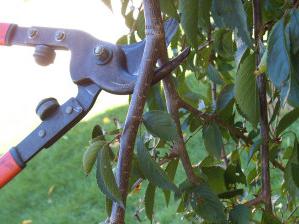
Pruning adult tree
The pruning of an adult bush cherry is made in order to rejuvenate a tree and increase its productivity. This procedure is performed when fruiting is reduced. The scheme of cutting the cherry in the spring is as follows: they reduce the number of branches and shorten them by a third or half the length of the shoot. In addition, it is necessary to remove skeletal and semi-skeletal branches, but not in one year for the tree to bear fruit. It is not necessary to make the removal of annual increments.
In the old tree cherry need to slightly shorten the annual shoots. This rejuvenation is necessary when the skeletal branches become bare at the base and the growth of shoots slows down (less than 15 cm per year).
When pruning old trees, it is necessary to remember that it is not recommended to immediately get rid of a large number of branches, rejuvenation should be carried out in stages, over several years.
Cherry is not a capricious plant. But to get a good harvest, you need proper care for cherries in the spring, as well as throughout the year.
fb.ru
Pruning cherry in spring: video and scheme of pruning young and old trees
Features pruning cherry
The rules for pruning a cherry are based on its physiological characteristics.
There are two main groups of varieties of cherry - bushy and tree. This separation is due to the nature of fruiting. But let's go back to pruning. Cherry branches are of three types:
- Short - do not exceed a length of 20cm, on which are located the sides of the kidneys. They carry generative and vegetative buds.
- Growth - their length is up to 50cm and they only carry vegetative buds.
- Mixed - do not exceed 40 cm in length and carry both vegetative and generative buds
Bush varieties usually bear fruit rather quickly - after 2-3 years. The bulk of the fruit is located on the branches of mixed type. The yield of cherries depends entirely on the formation of new buds on these branches, therefore, when pruning the bushy cherries be sure to take this into account.
In trees, the basis of fruiting and yield is the annual formation of new buds - on short branches only generative buds form over time, while new bouquet buds become smaller.
Rules and terms of trimming
To cut the tree is best in early spring at a temperature not lower than -8 degrees in warm, dry weather and you need to have time before the sap flow begins.
Trees of cherry trees, which have weak branching, have a crown of 5 or 6 main branches. For those varieties that have a stronger structure, choose a freely growing shape and tierless placement of branches.
Pruning of artisan-type cherries is somewhat different from the tree-like one - here the bezless crown is formed from 7-8 main branches that are evenly spaced along the trunk. If the tree is very running, then it is necessary to focus on thinning the branches.
The first post-plant pruning of cherry trees
a) tree before pruning b) tree after pruning
As soon as there is a decline in growth, as evidenced by the length of the shoots no more than 15-20 cm, it is necessary to make a light rejuvenating pruning of cherries. In the place of bending, hanging branches receive enhanced nourishment and tops are formed, which lead to branching. The parts of the branches that are located in front of these branches must be cut, as they have already served their own.
Reaction of the newly planted cherry tree to pruning after the beginning of the growing season
Video: how to cut a cherry
From this video you will learn:
- What is the most common mistake when forming the crown of cherry
- What is different from pruning cherries pruning other trees
- How to conduct a rejuvenating pruned cherry
- How to prune young cherry trees
When the formation of the tree is over, pruning can be stopped for a while.
Cherry trees, which are older than 10 years, weaken the formation of new shoots, focusing fruiting on the generative buds of annual branches. In order to avoid a fall in yield, do not shorten these branches - it is better to cut them entirely to stimulate the growth of new ones.
Pruning 2-3 year old cherry wood, as well as lightening its crown, has a very good effect on the development of the tree as a whole.
Site sait-pro-dachu.ru wishes you good luck and high yield!
sait-pro-dachu.ru
Cherry wood pruning workshop
So, how to cut the cherries?
Firstly, it is necessary to say that the optimum height of a tree is 2-2.5 m, which gardeners strive for when forming young trees. But in practice in our gardens you can see cherries reaching 3, 4 and more meters in height. In this case, you can only advise one thing - cut the top to the height that will be comfortable for harvesting. The cut should be done over the nearest thick branch, after which it is necessary to cover it with a garden pitch. With the same composition, when cutting, it is necessary to lubricate all sections of branches that are larger than 1 cm in diameter.
Although it is obvious, but once again we remind you that pruning both cherries and any fruit-bearing tree must be done with a well-sharpened shears.
After we dealt with the height of the tree, we begin the actual pruning. It should include two main stages: clearing the crown of unnecessary branches and giving it the correct shape.
In order to remove extra branches, you need to know a few simple rules. First, you need to cut those branches that intersect with others and do not allow them to grow in full force. If you are in doubt about which branch to cut, choose the one with the lowest number of flower buds. Very often (especially this concerns old trees) one can see branches bare almost the entire length, and only a few buds are present at the ends. They need to do so. If the buds are very small, then they cut the entire branch, while cutting it off at the base. If you still want to keep the branch, then cut only part of it, while leaving half of the buds. In no case do not cut the entire area with the kidneys: in the place where they are not, they will not grow.
Branches growing below the first skeletal branches, growing vertically up and down, are subject to mandatory removal. The branches thickening the crown are removed, but the main thing here is not to overdo it, the crown of the cherry should be thicker than that of the other fruit trees.
Remove those branches that are too thick crown. The main thing here is not to overdo it, because the cherry is not an apple tree, and its crown should be somewhat thicker than that of other fruit trees in your area. Get rid of the dried branches as well - they don’t need a tree.
How to cut a young cherry
If your tree is still quite young, then you must make sure that its crown is formed correctly. To do this, the shoots that have appeared on the trunk that you did not have time to cut in the summer, must be removed in the fall.
A sapling should not be pruned in the very first autumn, as this increases the risk of its freezing in winter in places of cuts.
The main task of cutting cherries in the first years of life is the formation of the crown. To do this, delete the branches that grow inside the crown and the branches that grow too fast up
In the future, make sure that the number of branches is not excessive, which leads to an early thickening of the crown. Otherwise, you will need to carry out more pruning, and this is just undesirable. Those branches that grow inward towards the crown, must be removed, while observing moderation. Sprigs that grow too far up need to be cut so that the tree does not grow too high.
As the tree develops, it is necessary to leave skeletal branches on the trunk so that in the end there will be 12-15. These branches should be placed along the trunk evenly. Remove the remaining branches, and try not to leave stumps around which the bark can die off on the cherry.
Do not limit the growth of the side branches, if they have enough space for this. If you see that a branch does not grow where you would like, you can easily put it into the necessary sector with a trim to transfer it.
Suppose you decide that your tree is already high enough and no longer want it to grow up. In this case, pinch off its tops (if there are several of them), which will give the cherry a push for lateral growth.
Tree and bush cherries: pruning technology
To cut the cherry correctly, you need to know exactly what kind of it grows in your area: tree or bush cherry. The difference between them is not at all in appearance (both are usually grown in the form of a tree). The fact is that the tree cherry fruits are located on special branches - the bouquet, which bear fruit for several years. In bush cherry fruit twigs are annuals.
The scheme of pruning bushwood and tree cherry, which must be performed in the fall
First, let's talk about bush cherry. If you notice that the ends of the branches began to bare, this means that it is time to make a light rejuvenation. To do this, cut the branches of the 1st and 2nd orders near the strongest branching, making sure that the branches grow in the right direction. To avoid exposure, branches are pruned in places where growth is observed and the strongest prior branching is observed. At the last stage, the upper branches should be directed to the middle of the crown, and the lower branches should be trimmed up.
In order to properly trim the tree cherry, watch the annual growth of branches. If it is less than 15 cm, then it is necessary to carry out a rejuvenating trim. If the ends of the branches or entire branches dry out, then rejuvenating pruning is carried out on the lateral branches located on the five-year branches.
There are a few more rules:
- If tree species remove annual shoots brings only good, then for bush cherries this is undesirable because it threatens with the drying of the entire branch.
- On old trees, you should not immediately delete a large number of branches. You may have missed several seasons of pruning and your cherry is in disrepair. In this case, the branches should also be removed for several seasons, in order not to arrange a shock for the tree.
- If sprouts appear around the cherry, it should be completely removed, leaving no hemp.
And the last. If you still fear that pruning may harm your cherry, fertilize it more actively during the previous year, and then removing the branches will not harm it.

